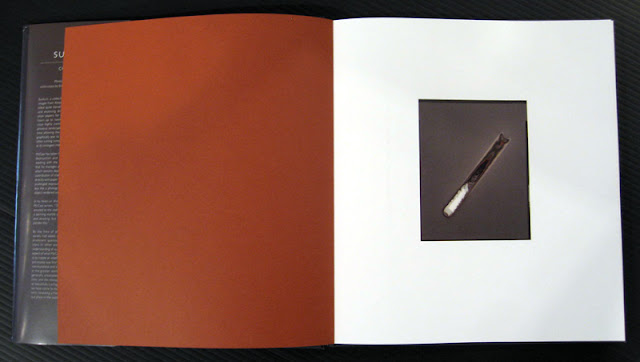 |
A Possible Life. By Ben Krewinkel.
Published by f0.23, 2012.
|
A Possible Life
Reviewed by Colin Pantall
A Possible Life
By Ben Krewinkel.
f0.23 publishers, 2012. Softcover. 80 pp., color illustrations throughout, 8-1/4x11-3/4".
A Possible Life is a book about an illegal immigrant to the Netherlands. His name is Gualbert and with the photographer Ben Krewinkel, he's the co-author of the book. Gualbert comes from Nigeria and has lived in the Netherlands for the last 10 years. Maybe. Or perhaps he comes from Niger because that's what all his papers are stamped with. Or perhaps his name isn't Gualbert and he's not a migrant because Krewinkel says that reading the book '...as a non-fictional and objective story purely, might be considered naive.' Instead Krewinkel regards the book is a partly fictitious account of an illegal immigrant’s life, one told through a collection of personal photographs, letters, conversations and official documents.
The real/fictional play is possibly the least interesting part of
A Possible Life, so for the purpose of this review I'll ignore it. I'll take the naive path and view the book as non-fictional. It starts on the inside cover with an insight into how the project started and the editing process employed by both Krewinkel and Gualbert. In one email, Gualbert asks to be described as from Nigeria, not Niger. He asks for his face to be disguised in photographed, then calls for God's blessing on the project before asking for help with his children’s school fees, something Krewinkel can't help him with. Then the book starts proper with a series of copies of Gualbert's papers; his passport, his resume, bank transactions.
Papers slip from the banality of officialdom to the tragedy of the personal. There's a picture of a young woman next to a transcribed comment from a recording Krewinkel made on his sister's death from AIDS. 'In Africa, when you have aids some accept you, but mostly they reject you, you are being marginalized.'
Gualbert's marriage certificate is shown next to snapshots from the family album and more transcribed comments on the dilemma he faces. In the Netherlands, Gualbert is a nobody, but back home in Niger he is regarded as wealthy, a pocket to turn to when medical bills or school fees need paying.
And that's the Catch-22 Gualbert faces. As Krewinkel writes, '...Gualbert has come to realise that, without proper documents or a working permit, there is no real future ahead in the Netherlands. He obviously aspires to join his family, but lacks the money for a return without losing face.... Many friends and relatives would be disappointed if Gualbert returned empty-handed.'
On top of that, there is the current climate of intolerance in the Netherlands that has led to people like '...Gualbert being more marginalised than ever before.'
So what to do. Krewinkel has produced a wonderful documentation of a migrant’s life, using multiple sources and a variety of perspectives. The bureaucratic vision of life gives way to the personal, of a life once lived, with family album snapshots of life in Niger playing against the Possible Life where Gualbert is photographed in some kind of Dutch Migrant’s Hostel. There he is cooking, sitting, and smiling in ever such an institutional manner.
Except the book doesn't end there. It comes with instructions on how to view Krewinkel's own pictures of Gualbert; 'To fully view all the pages of this publication, please use a letter opener or another sharp object to open the Japanese bound book. Do be careful!'
So to see the book, you have to destroy the book. Infuriating but very clever. The process of cutting the book slows everything down. Cut then view, cut then view, cut then view; this builds up a narrative. Krewinkel's own portraits are ones of isolation, disappointment and squalor. Money worries come to the forefront as does the bleak loneliness of being so far from home, so powerless, so unwanted. And even when Gualbert is wanted, doubts and questions creep in. Wanted for what? As a husband, a father, a friend or as a bankroll, the man in Europe who is failing to cash in people's dreams.
Beautifully designed and thought out,
A Possible Life is a multifaceted book that makes a coherent whole out of a huge mix of materials. Krewinkel carves a life out of documents, letters, notes and photographs. That is no mean achievement. What elevates the book even further is the hidden element, that concealed subconscious you have to cut through, that world of sorrow and loneliness that lies beneath. Combining complexity and subtlety, Krewinkel has come up with a very human, and emotional documentation of what living in the limbo of an illegal immigrant means.
But still the question remains. Do you cut it or don't you cut it? And if you do, do you buy another copy to satisfy your collector's neurosis? I will.
—COLIN PANTALL
purchase book
COLIN PANTALL is a UK-based writer, photographer and teacher - he is currently a visiting lecturer in Documentary Photography at the University of Wales. His work has been exhibited in London, Amsterdam, Manchester and Rome and his Sofa Portraits will be published as a handmade book early next year. Further thoughts of Colin Pantall can be found on his blog, which was listed as one of Wired.com’s favourites earlier this year.






















